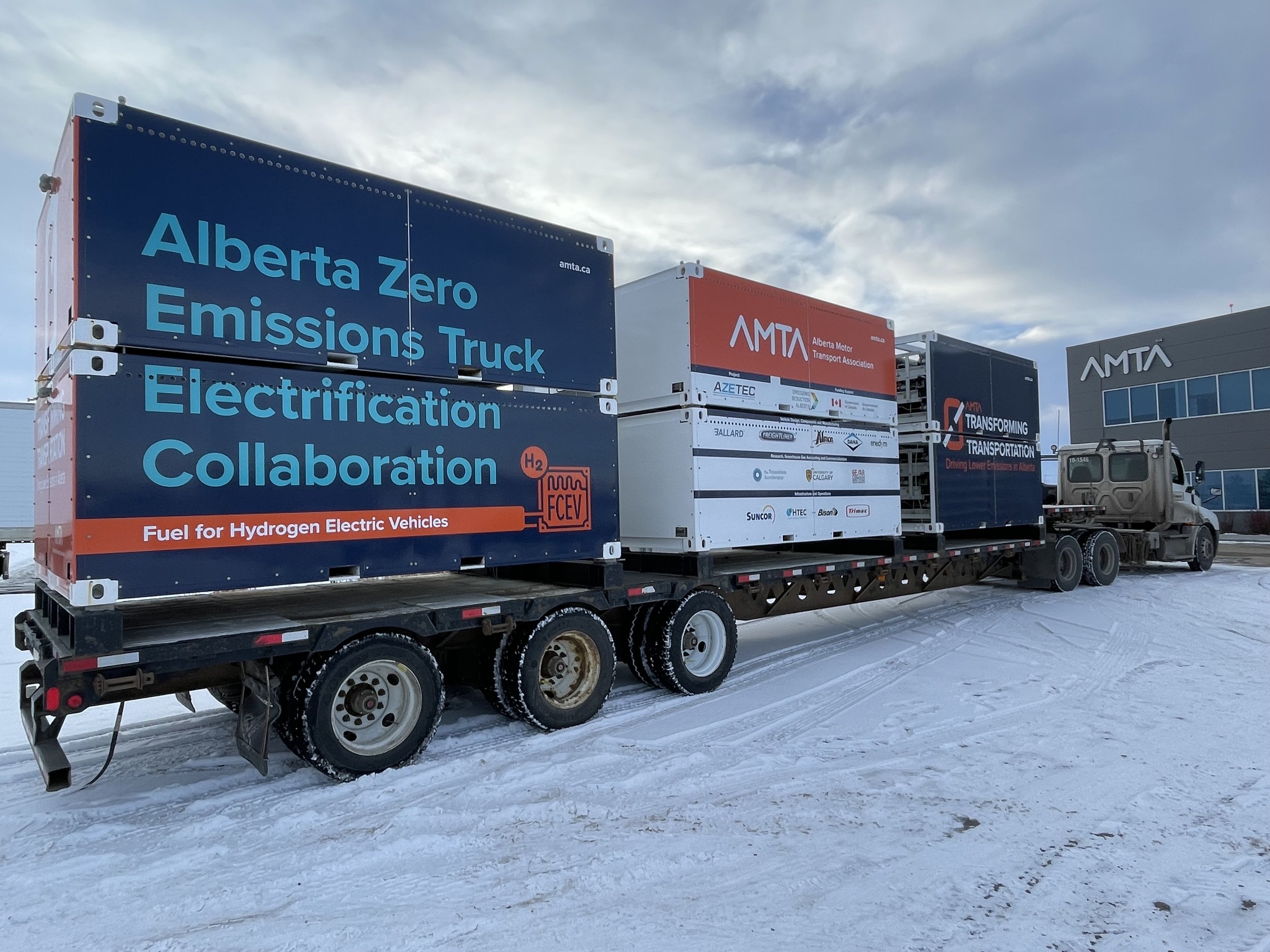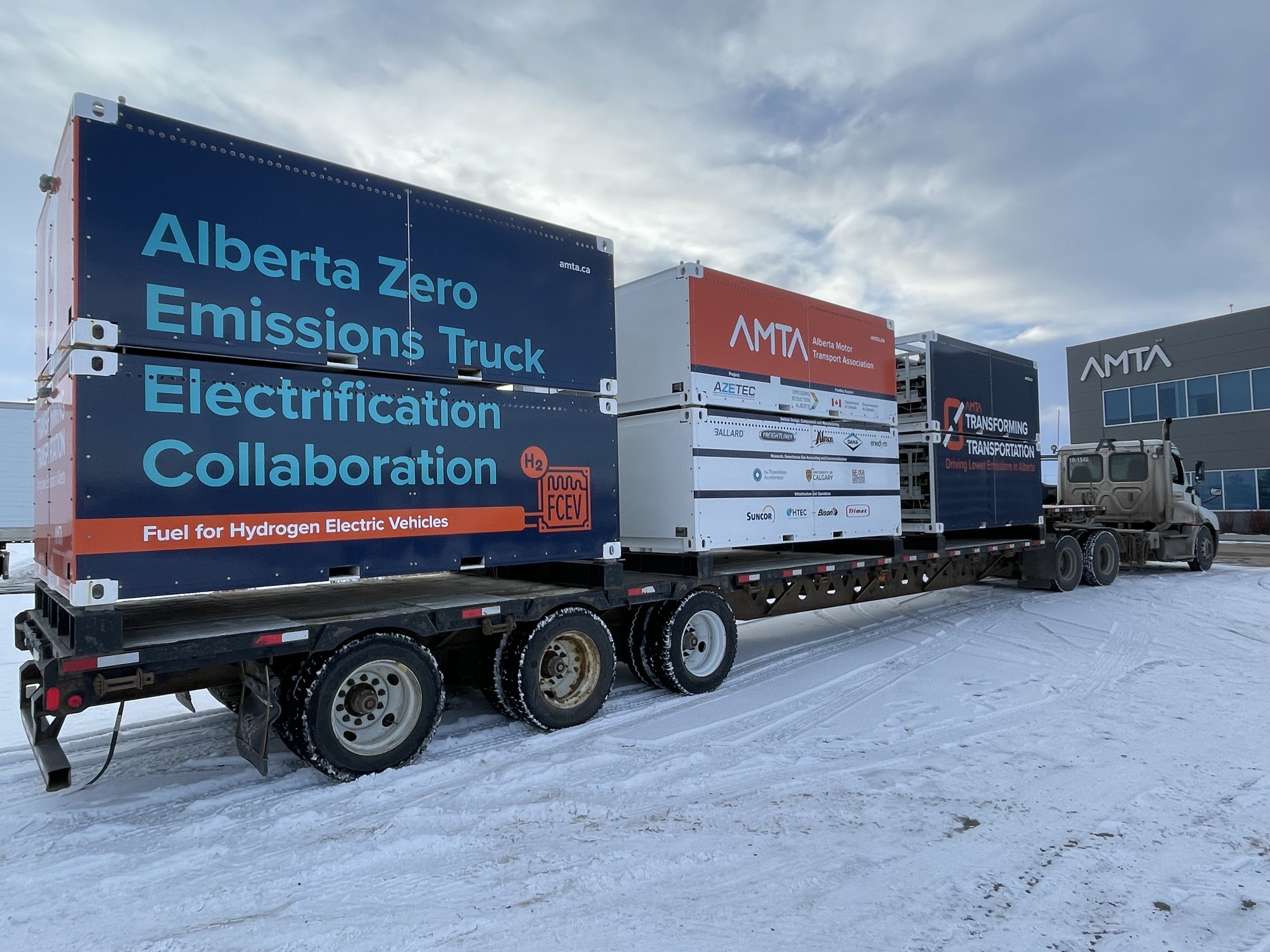
Class 8 hydrogen fuel cell electric truck, custom built for the AZETEC project.
To date, fuel cell grade hydrogen is being produced at the Suncor facility near Edmonton and both Class 8 hydrogen fuel cell trucks have completed track testing. Canadian vehicle certification is being attained. Once certified, both vehicles will be placed into operational service. One truck will be operated by Bison Transport and the other with Trimac Transportation. Key partnerships and funding for this project is provided by Emissions Reduction Alberta (ERA), Suncor, Ballard Power Systems, Dana, Almon, Enedym, Freightliner, Bison, Trimac, Hydrogen Technology and Energy Corporation (HTEC), Transition Accelerator, and Canadian Energy Systems Analysis Research (CESAR).
Beyond designing and building the AZETEC trucks and establishing a hydrogen fuel supply, hydrogen storage and dispensing were also required. This is where the Electric Vehicle Infrastructure Demonstration (EVID) project, funded by Natural Resources Canada, plays a major role.
Suncor hydrogen is produced at the Edmonton refinery, then transferred a short distance to a separate terminal site for hydrogen fueling. A Power Cube Trailer, designed by HTEC, is filled with 516 kg of fuel cell grade hydrogen (99.999% purity) at 450 bar and is transported from the refinery to the terminal. At the terminal site, hydrogen from the trailer flows through a gas transfer module that dispenses hydrogen by cascade filling into the vehicles. Having a process for hydrogen fueling presented an opportunity to support several additional hydrogen vehicles in Alberta that currently include:
-
Two Alberta Zero-Emissions Hydrogen Transit buses
-
Three Hydra hydrogen-diesel dual fuel trucks
-
One Hyzon fuel cell electric truck
-
Three Nikola fuel cell electric trucks
-
Two AZETEC fuel cell electric trucks
-
University of Alberta and Cummins hydrogen combustion engine research
Plans are underway to develop additional hydrogen fueling stations that will enable hydrogen trucks to complete trips between Calgary and Edmonton, opening the door for more hydrogen vehicles to operate in Southern Alberta. Additional hydrogen fueling stations are an important next step towards extending Edmonton’s hydrogen hub into the first regional hydrogen corridor in Alberta hauling cargo between Calgary and Edmonton.
Establishing this hydrogen corridor lays the groundwork for building a sustainable ecosystem with hydrogen supply supporting vehicle demand. The hub/corridor model is being proven as feasible and scalable in Alberta and to other regions within Canada.
AMTA HYDROGEN VEHICLE DEMONSTRATIONS AND AWARENESS CAMPAIGNS
With hydrogen fueling occurring in the Edmonton region, AMTA seized the opportunity to advance stakeholder awareness and education on zero emission vehicles through the PrairiesCan Hydrogen Vehicle Demonstrations and Natural Resources Canada’s Zero-Emission Vehicle Awareness Initiative (ZEVAI).
AMTA members expressed a high level of interest in gaining hands-on experience with pioneering hydrogen technology which led to the development of the Hydrogen Vehicle Demonstration program. To participate in the Hydrogen Vehicle Demonstrations, operators are required to complete in-cab and online training prior to driving the hydrogen vehicles within their normal business operations. This program is rolled out as short-term (2-week) lease contracts with interested carriers. Over the course of the vehicle demonstrations, AMTA interacts with the fleet to collect driver experience and vehicle performance data to provide insight into the pros and cons of the vehicles from the fleet and driver’s perspectives. To date, AMTA has engaged with over 60 carrier companies, and trials have been conducted by more than 30 carriers in the Edmonton region.
AMTA’s Hydrogen Vehicle Demonstrations have showcased two types of hydrogen trucks: FCEVs provided by Hyzon and Nikola and hydrogen-diesel dual fuel vehicles provided by Hydra. Hydrogen FCEVs are powered only by hydrogen and have zero tailpipe emissions other than water vapor. The hydrogen-diesel dual fuel vehicles are retrofits added to existing diesel internal combustion engines. The retrofit design allows hydrogen and diesel to be co-combusted in the engine, and results in reduced GHG emissions. These retrofits offer a relatively low upfront cost to install, providing a significant benefit for existing assets that don’t depreciate quickly (e.g., diesel transit buses with an expected service lifetime of ~25 years). The key difference is that hydrogen-diesel dual fuel retrofits reduce emissions while FCEVs achieve zero emissions mobility.
Under the ZEVAI program, several educational programs were developed to support the safe operation of hydrogen vehicles on Canada’s roadways. An online course was created to review hydrogen properties, provide basic information on what is a fuel cell electric vehicle and to understand how to safely operate this emerging technology.⁵ In-person courses were developed on topics including driver training, mechanic training, tow truck operator training, and first responder awareness.
Overall, based on the breadth of engagement and interest in hydrogen vehicles, we found that there were many opportunities for outreach and education directly through vehicle demonstrations and training as well as other in-person events such as industry sessions, convention displays, webinars, regional meetings and through our website.⁶ AMTA has been invited to deliver numerous speaking engagements to extend awareness of the successes and lessons learned through interactions with hydrogen technologies. Additionally, we developed a media strategy and completed several media sessions related to the vehicle demonstrations and awareness of hydrogen vehicles in Canada.
In total, through the ZEVAI programs, AMTA was able to reach thousands of people:
-
600 people drove in a hydrogen FCEV or hydrogen diesel dual fuel vehicle;
-
170 people received one-on-one driver training (and operated a hydrogen FCEV or hydrogen-diesel dual fuel vehicle); and
-
20,000 people viewed and touched the FCEV or hydrogen-diesel dual fuel vehicles that were exhibited at various conventions and summits.




